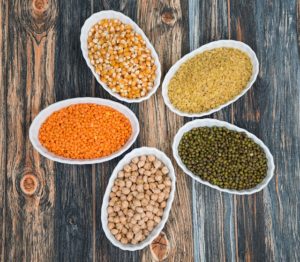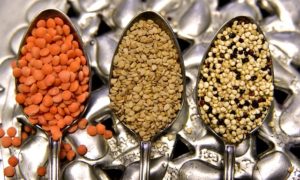 “Bland, boring and they only belong in soups…”
“Bland, boring and they only belong in soups…”
Is this your perception of lentils?
Honestly, that used to be our perception. We never really had lentils until we started our REAL food journey and started trying all kinds of new foods. Well, let’s just say our perception was wrong! We discovered their great taste and versatility, not to mention how affordable they are and the amazing nutrients they provide.
If you’re where we were — unfamiliar with lentils, including how to prepare them and what in the world to do with them — we want to help!
For good reason, lentils are our Superfood of the Month for January!
What are lentils?
Lentils are legumes that are grown in pods…these pods are found on plants that can grow as tall as 1 to 2 feet. They originated in Asia and have been around for over 8,000 years and are popular in Middle Eastern, Greek, French and Indian cuisines. Canada is the leading producer of lentils and they come in a wide variety of shapes and colors, including brown, yellow, green, red, and black.
Green and brown lentils are the most common in the U.S. because they are the best at retaining their shape after cooking. If stored in a cool, dark location, dried lentils can literally last for years.
Lentil color guide:
 Brown lentils: typically the least expensive! These soften quite a bit when cooked, which makes them ideal for soups and stews.
Brown lentils: typically the least expensive! These soften quite a bit when cooked, which makes them ideal for soups and stews.- Green lentils: have a nuttier flavor, and stay fairly firm when cooked.
- Red lentils: their color is often more orange than red, and the color will fade when cooked. They have the most mild taste and typically cook the fastest. Out of all of the lentil varieties, red lentils are the most likely to lose their shape when cooked, making them best suited for soups, stews and curries. These are the most common lentils used in Indian cuisine.
- Black lentils: know as beluga lentils, this is one of the smallest varieties and resemble caviar when cooked.
Why is it important to make lentils part of our routine?
Lentils are a cancer-fighting superfood that have a ton of nutritional benefits! They are low in fat and high in protein…they have one of the highest amounts of protein of any plant and are an excellent protein replacement for those who don’t eat meat. They are high in folate, which helps lower the risk of heart disease and is excellent for pregnant women, reducing the risk of birth defects. Lentils are also loaded with soluble fiber, which helps keep cholesterol down, cleans your digestive system and keeps blood sugars under control. It doesn’t stop there…they are a great source of iron, phosphorus and other nutrients…a nutrition powerhouse!
How do you cook lentils?
Lentils are super-easy to prepare because they don’t need to be soaked like dried beans. One cup of dried lentils will make 2 to 2 1/2 cups of cooked lentils. Lentils are typically cooked with a 1:2 or 1:3 ratio of lentils to water, but the most important thing to remember is lentils cook similar to pasta. You want to cook them until tender but firm, and then drain the excess liquid when done (unlike rice or other grains where you cook until the liquid is absorbed).
 To cook lentils, bring them to a boil, and then reduce the heat to a simmer until they are tender. The more popular varieties, like green lentils, will take 15-20 minutes. Other varieties may take anywhere from 10 minutes to 40 minutes, so the best bet is to test them periodically as they are cooking to get them to the right consistency.
To cook lentils, bring them to a boil, and then reduce the heat to a simmer until they are tender. The more popular varieties, like green lentils, will take 15-20 minutes. Other varieties may take anywhere from 10 minutes to 40 minutes, so the best bet is to test them periodically as they are cooking to get them to the right consistency.
Lentils are most commonly consumed in soups and stews, but we have found them to be great in salads and many other meals! As you probably expected, we have some delicious Eat REAL America ideas for you to try!
Roasted Broccoli and Lentil Salad
Tasting is believing…
so try lentils in different ways throughout the month of January and see how to enjoy this fantastic Superfood!
Share with us — do you have a favorite way to serve lentils?
 LEARN MORE ABOUT THE NAPKIN!
LEARN MORE ABOUT THE NAPKIN!


Leave A Comment